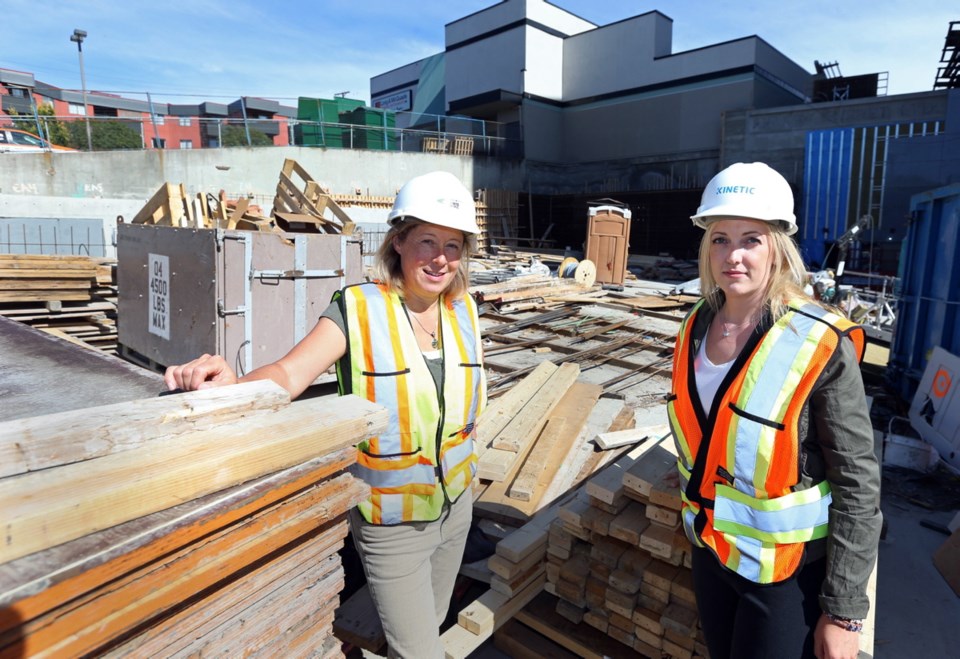Earning an electrician’s ticket was a natural move for Victoria’s Cheryl Hartman. After all, she grew up in a family of tradesworkers.
But when Hartman, 44, was studying in Vancouver, there was only a handful of women taking similar training. Two decades later, she’s trying to change those kinds of statistics in her trades outreach role with the one-year-old Women in Construction committee, part of the Vancouver Island Construction Association.
The Women in Construction group is striving to promote women in all sectors of the industry — from the shop floor to senior managers and owners. Its goal is to be inclusive and encourage networking and support among women already in or interested in construction.
“I love my choice. I would never, ever change,” Hartman said. “I wish more women would get into it.”
She has worked for Victoria’s Brewis Electric seven years, starting as a forewoman. The company is sponsoring her education as a gold-seal estimator. A gold seal is an industry certification.
Working in construction is an empowering, fulfilling, and well-paid route for women, she said.
“I own a house. I own a newer vehicle. I’ve gone to Europe.”
Girls need to hear in school that the trades are an option, Hartman said.
Women are being actively recruited for trades training these days to help offset labour shortages.
B.C.’s Industry Training Authority has launched an initiative, with help from the federal government, to encourage women to join the trades, stating: “Today, the door is open to women in every B.C. trades career. You’ve got great trade career choices — from carpentry and plumbing to aerospace and horticulture. Women are finding challenges, job satisfaction and good pay in the skilled trades.”
B.C.’s economy relies in part on the health of the construction industry, a major economic generator.
The B.C. Major Projects Inventory, published by the province, listed 26 projects for the first quarter of this year. Either underway or planned, projects that made the cut were valued at more than $15 million each for most of B.C., and more than $20 million each in the Lower Mainland and Vancouver.
There’s a further $2.2 billion in possible capital investments if planned projects go ahead.
Greg Baynton, Vancouver Island Construction Association chief executive officer, said: “Women are an important, underrepresented and growing human resource element of the construction industry.”
A Construction Sector Council report from 2010 said that even with higher numbers of women joining, they made up just 12.6 per cent of Canada’s construction industry’s workforce in 2006.
Even more telling, women represented only four per cent of workers in the construction trades.
The council’s report called for greater efforts to recruit women, as well as men, for trades apprentices. The council heard from focus groups on such recommendations as ensuring high school students are aware of construction trades and management opportunities, and having women in the industry talk about what they’re doing.
Other suggestions included establishing family-friendly workplaces to serve both men and women.
Katy Fairley, business development manager for Victoria’s Kinetic Construction, was a key force in establishing the Women in Construction group, now numbering close to 200 members.
Members include architects, consultants, engineers, project managers, business owners, administrative staff, project accountants and workers in the trades.
When it comes to trades, Fairley said, “You are seeing a societal shift toward recognizing blue-collar jobs. You are going to make good money. You are going to be part of the middle class and, frankly, you are probably going to be employed for the rest of your life.”
A construction job, however, does not necessarily mean being at a building site. That’s only part of the industry, Fairley said. Someone could work at an office, with a computer or managing contracts. Project managers and site superintendents can earn more than $100,000 annually, she said.
Fairley studied political science and international relations at university and had not originally considered construction as a possible career.
She joined the construction industry three-and-a-half years ago when she started at Kinetic, where she has been encouraged to progress in her career.
Once at Kinetic, “I immediately felt a click with my personality. ... Right away I was like, ‘I love this industry.’ ”
Fairley said she wanted to meet other women who share her passion, and she wants others to know it is a viable career option. “I want to spread the word that this is a great industry to work in to other women, because I never thought I would be working in construction.”
Vancouver Island companies have been supportive of the group, she said.
> On the web:
• Vancouver Island Construction Association: vicabc.ca
• The Canadian Association of Women in Construction: cawic.ca
• Canadian Construction Women: constructionwomen.org



